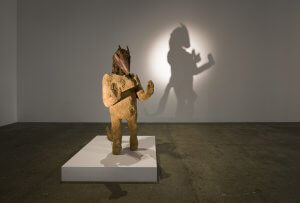Ali Cherri: Humble and quiet and soothing as mud | Hyperallergic
Nov 08 2023

Ali Cherry’s Muddy Affair
Mud is at the beginning and end of life on earth. This deceptively simple proposition is taken up by Lebanese visual artist and filmmaker Ali Cherri in his United States debut solo show Humble and quiet and soothing as mud. In new sculptures and the three-channel film “Of Men and Gods and Mud” (2022), Cherri elevates mud as a primordial material and a source of timeless storytelling.
Cherri’s exhibition restages the mournful scene of the lamentation of Gilgamesh, a dramatic segment of the Mesopotamian epic in which the two best friends, Gilgamesh and Enkidu, are separated by the latter’s unexpected death. Visitors first intrude upon a large-scale mud sculpture representing Gilgamesh, King of Uruk, holding his hands to his heart and hunched forward in grief. In front of him sits a pile of earth on which stand bull horns, hinting at the circumstances leading to Enkidu’s death. According to the epic, the gods sentence Enkidu, whom the goddess Aruru originally made from clay, after he and Gilgamesh kill a sacred bull.
Cuneiform tablets record a quote immortalizing Gilgamesh’s anguish: “My friend, whom I love, has turned to clay.” In Cherri’s retelling, there are other witnesses to this shocking realization of mortality: a prostrated “Leaning Figure” and a stunned “Standing Figure (Pow!).” In an adjoining room, a boy with arms reaching to the ground like the roots of a tree contemplates his own outline in solitude in “The Dreamer.”
Through carefully choreographed lighting, which casts shadows against the walls, the sculptures seem to come to life like the characters of a puppetry performance, communicating in silence but dynamically as the visitor engages with various vantage points: the dead, the weeper, the bystander. Their bodies are made from clay and sand, and on their faces sit repurposed historical masks, all artifacts from France, Mali, and other provenances, that Cherri buys at auction (his Gilgamesh aptly wears a funerary mask from Egypt). The masks serve to anonymize the figures — to conceal and protect — but also to ennoble discarded, forgotten art objects. In doing so, Cherri interrogates what is excluded from institutional shows and museum collections, a longtime concern for the artist. Like Enkidu, the masks transition into another life — in this case, from the market into Cherri’s collection, where they become part of his artworks. While this circularity unfolds, the viewer contemplates the complexities of authenticity. The sarcophagus mask can channel various identities — Late Period of Egypt, pseudo-Mesopotamian, contemporary — thus complicating our relationship to them.
Mud connects the past to the present via tradition, artifacts, and repeated gestures. Humans physically work the material but also relate to it devotionally. Cherri explores these dual dimensions best in “Of Men and Gods and Mud,” which follows a group of artisanal brickmakers in northern Sudan. The short documentary film highlights their daily labor and spiritual longings, recounted in the poetic and philosophical style of a modern epic. In solemn, lyrical voiceovers, musician Jamika Ajalon and translator Mariam Janjelo read a text in English and Arabic, respectively, penned by Lebanese writer Lina Mounzer specifically for this exhibition. Shots that interlace the men’s work, the sky, and the river’s potency suggest the familiarity of rituals set in a Hesiodian fresco.
Cherri’s approach to metamorphosis is compelling: Humans have transformed the material of mud since the dawn of civilization, a relationship that continuously stirs something in the soul and alters how we relate to creation and death. This leaves us with a riveting tale of culture and infatuation, as we can’t quite extract ourselves from this entangled history. As long as there’s air, water, and earth, humankind’s saga survives.
